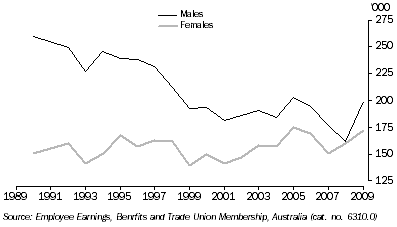RECENT ECONOMIC STATISTICS
Employee Earnings, Benefits and Trade Union Membership, Australia, August 2009
Employee Earnings, Benefits and Trade Union Membership, Australia, August 2009 (cat. no. 6310.0) was released on 12 May 2010.
This publication contains information from three survey topics: weekly earnings of employees, core employment benefits and trade union members. Weekly earnings data shows the distribution of weekly earnings of all wage and salary earners classified by full-time/part-time employees, employees with or without leave entitlements, sector, hours worked and hours paid. Core employment benefits data includes information relating to sick leave, annual leave, long-service leave, maternity/paternity leave and superannuation coverage. Information about the level of trade union membership is also provided. For each of these topics estimates can be cross-classified by demographics such as state, sex, age, marital status, birthplace; and by labour force characteristics such as industry of main job and occupation of main job.
Some data for Queensland:
- In 2009, there were 198,600 males who were members of a trade union in their main job and 788,300 who were not members. Corresponding figures for females were 172,500 members and 730,200 non-members. Trade union membership has declined from 1990 levels for males but has increased 23% from 2008. Membership for females has remained about the same level and has increased 8.1% from 2007.
Trade Union Membership, Queensland

International Trade in Services by Country, by State and by Detailed Services Category, Calendar Year, 2009
International Trade in Services by Country, by State and by Detailed Services Category, Calendar Year, 2009 (cat. no. 5368.0.55.004) was released on 14 May 2010.
The spreadsheets contain trade in services credits and debits data for: country and country groups by calendar years; calendar years by country and country groups; state by calendar years; calendar years by state; detailed travel service by calendar years by country and country groups; and education related travel credits by calendar years by educational sector by type of expenditure. A full range of data is available from 2000.
Some data for Queensland:
- In 2009, the total credits of international trade in services was $8,972 million, a 2.3% decrease from 2008. The largest contribution to this total was travel, accounting for $6,430 million in 2009, with education-related personal travel accounting for $2,686 million of credits, 27% more than in 2008.
- Total debits of international trade in services for 2009 were $7,124 million, a 10% decrease from 2008. Travel was the largest contributor, accounting for $4,048 million of debits in 2009. Education-related personal travel accounted for only $132 million of the travel debits.
Australian Industry, 2008-09
Australian Industry, 2008-09 (cat. no. 8155.0) was released on 28 May 2010.
Presents estimates derived using a combination of data from the Economic Activity Survey and business tax data sourced from the Australian Tax Office. For most industry divisions and subdivisions (as specified in the Australian and New Zealand Industrial Classification (ANZSIC), 2006 edition), estimates at a national level are presented of: income; expenses; industry value added; operating profit before tax; capital expenditure; and selected components of these aggregates and derivations. State/territory estimates of income, employment, and wages and salaries, at the division level are also included.
Some data for Queensland:
- The industry with the largest growth in sales and service income between 2007-08 and 2008-09 was mining with a 66% increase from $27,633 million to $45,907 million. The total wages and salaries for mining increased 25% over the same period.
- Manufacturing showed the largest sales and service income of $78,316 million in 2008-09 and grew 4.6% from 2007-08. Wages and salaries for manufacturing decreased 1.8% over the same period, while employment decreased 8.5%.
- Construction had the largest total of wages and salaries in 2008-09 with $10,227 million, an 8.0% increase from 2007-08. Construction also had the largest employment of 256,000 persons in 2008-09.
- Retail trade had the second largest employment of 253,000 persons in 2008-09. Total wages and salaries were $6,521 million in 2008-09.
 Print Page
Print Page
 Print All
Print All